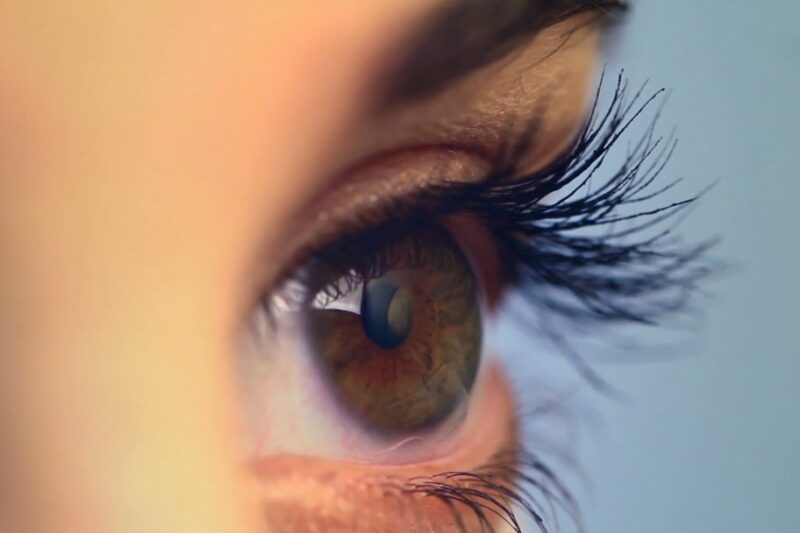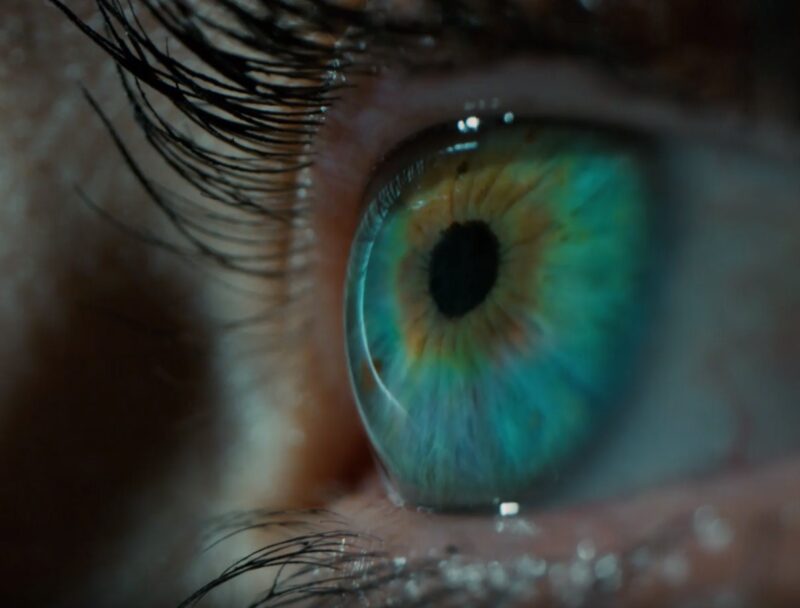Toric contact lenses are a specialized type of corrective eyewear designed for individuals with astigmatism. But what exactly are they, and how do they differ from regular contact lenses?
In this guide, we’ll explore the specifics of toric contact lenses and how they can help you achieve clearer vision.
Key Features

Astigmatism, characterized by an irregular curvature of the cornea or lens, disrupts the light-focusing process within the eye, resulting in blurred or distorted vision. This refractive error necessitates a unique corrective approach, one that transcends the capabilities of standard spherical lenses.
It is not merely a singular condition but manifests in diverse forms and degrees, each with its unique implications for vision and correction.
Toric lenses, with their distinct design and orientation, emerge as a pivotal solution, adeptly managing the varying refractive errors present in astigmatism to render clear, undistorted vision.
Their capacity to remain stable on the eye, resisting rotation, ensures that the corrective powers are consistently aligned with the requisite meridians, providing reliable, clear vision across diverse activities and environments.
Dual-power Design

Toric contact lenses embody a design that is intrinsically tailored to address the challenges posed by astigmatism. Unlike spherical lenses, which have a uniform curvature across their surface, these lenses boast two different curvatures, or powers, designed to correct the refractive errors in two different meridians of the eye.
The dual-power design is pivotal in providing clear, sharp vision across all distances, ensuring that light is accurately focused on the retina, irrespective of the orientation. The stability of these lenses on the eye is paramount to their efficacy, necessitating a design that resists rotational forces and maintains optimal alignment with the eye’s meridians.
This is achieved through various design innovations, such as thin-thick zones, truncations, or ballasting, which ensure that the lens maintains its orientation, even amidst the dynamic movements of the eye.
This stability not only ensures consistent visual clarity but also enhances comfort, reducing the risk of lens displacement and the associated visual disturbances.
Choosing the Right Lens for You

You need to ensure that your chosen lens aligns seamlessly with your lifestyle, comfort preferences, and visual needs.
Material Matters
The material of your lenses plays a pivotal role in determining not only the clarity of your vision but also the comfort and health of your eyes. From soft to rigid gas permeable (RGP) lenses, each material offers its own unique benefits and considerations.
| Feature/Type | Soft Toric Lenses | RGP Toric Lenses |
|---|---|---|
| Comfort | Celebrated for comfort and adaptability | Rigid design offers a different wearing experience |
| Suitability for Newbies | Often the lens of choice for newcomers | May require a longer adaptation period |
| Vision Quality | Provides a gentle introduction to vision correction | Potentially offers a sharper vision |
| Durability | Generally less durable than RGP lenses | Durable and resistant to deposit accumulation |
| Best For | General vision correction | High degrees of astigmatism or those seeking a long-lasting lens |
Your eye care professional will guide you through the nuances of each material, ensuring that your chosen lens aligns with your visual and lifestyle needs.
When to Replace Them?

The replacement schedule of your toric lenses is not merely a logistical consideration but is intrinsically linked to the health and comfort of your eyes.
From daily to monthly lenses, each replacement schedule offers its own unique benefits and considerations, necessitating a thoughtful exploration of your lifestyle, hygiene preferences, and budget.
- Daily disposable lenses, with their fresh, clean wearing experience and minimal maintenance, offer unparalleled convenience, particularly for those with active or unpredictable lifestyles.
- Monthly or bi-weekly lenses, while necessitating a dedicated care and cleaning regimen, offer the economic and environmental benefits of reduced lens usage. Your eye care professional will explore your daily activities, travel habits, and budgetary considerations, guiding you toward a replacement schedule that not only ensures optimal visual clarity but also aligns seamlessly with your lifestyle and values.
Proper Fit and Care

The nuances of fit, from the orientation to the alignment, play a pivotal role in ensuring the efficacy and comfort of your lenses, while a dedicated approach to care is paramount in safeguarding the health of your eyes and the longevity of your lenses.
Precision in Placement
Ensuring a precise and comfortable fit is paramount when it comes to toric lenses, given their specialized design and the critical role orientation plays in achieving clear vision.
The fitting process, guided by a skilled eye care professional, involves a meticulous evaluation of your eye’s shape, size, and refractive errors, ensuring that the lens is tailored to your unique optical landscape.
The lens must align seamlessly with your eye, maintaining stability and optimal orientation to ensure consistent visual clarity across diverse environments and activities.
The fitting process may involve several iterations, with adjustments made to the lens’s power, orientation, and design to ensure optimal alignment with your eye’s meridians.
Safeguarding Your Eyes and Your Lenses

Once your toric lenses have been carefully adjusted, a dedicated approach to care and maintenance is the key to safeguarding both the longevity of your lenses and the health of your eyes.
For those who’ve undergone certain procedures like cataract surgery, understanding the importance of post-operative care, such as how long to wear an eye shield at night, is equally crucial.
From the choice of cleaning solution to the storage practices, each element of your care regimen plays a critical role in ensuring the ongoing efficacy and safety of your toric lenses. Here are some tips:
- Do Regular Eye Check-ups
- Always wash your hands thoroughly with soap and water before handling your toric lenses
- Use a recommended lens solution to clean and disinfect your toric lenses every time you remove them. Avoid using tap water or saliva, as they can introduce harmful microorganisms.
- Avoid Sleeping in Lenses
- Replace Your Lenses Regularly
- Always store your lenses in a clean lens case filled with fresh solution
- Avoid wearing your toric lenses while swimming, showering, or engaging in water sports
- Avoid Dusty or smoky environments
- If you wear makeup, always insert your toric lenses before applying it.
Common Issues and Solutions

Toric lenses, while transformative, may have their own set of challenges and hurdles. From adapting to the new visual landscape to navigating potential issues, it’s pivotal to be equipped with the knowledge and strategies to manage these challenges effectively.
Initial Adaptation
The initial adaptation to toric lenses can be a journey of its own, with the eyes and brain acclimating to the new visual input and lens sensation. Some individuals may experience a period of adjustment, where the clarity of vision and lens comfort may fluctuate as the eyes adapt to the new optical landscape.
It’s pivotal to navigate this phase with patience and adherence to the guidance provided by your eye care professional, ensuring that your eyes are given the requisite time and support to acclimate effectively.
During this adaptation phase, it’s crucial to communicate openly with your eye care professional, ensuring that any discomfort is addressed promptly and effectively.
Potential Challenges

While these lenses are a transformative solution for astigmatism, wearers may encounter common challenges such as lens rotation, dryness, or visual fluctuations.
Lens rotation, for instance, can disrupt the alignment of the lens with the eye’s meridians, impacting visual clarity and necessitating adjustments in the lens design or fitting parameters.
Dryness, a common challenge for many contact lens wearers, necessitates a thoughtful approach to lens material and care, ensuring that the eyes are supported with adequate moisture and that the lenses maintain their comfort and performance.
FAQs
Is it safe to sleep in my toric contact lenses?
While some toric lenses are designed to be safe for overnight wear, it’s essential to note that not all of them are suitable for continuous or extended wear while sleeping.
Always adhere to the wearing schedule and guidelines provided by your eye care professional and ensure that you select lenses specifically designed for overnight wear if this is a priority for you. Sleeping in lenses not designed for this purpose can increase the risk of eye infections and reduce overall eye health.
Are toric lenses available for people who need multifocal lenses?
Yes, multifocal toric contact lenses are available and designed to correct presbyopia (age-related farsightedness) in conjunction with astigmatism.
These lenses cater to diverse visual needs across varying distances, providing a clear vision for near, intermediate, and far objects while also correcting the irregular corneal curvature associated with astigmatism.
Can these lenses pop out of the eyes easily?
They are designed to provide a stable and secure fit on the eye, minimizing the risk of them inadvertently popping out. Their unique design, which often includes stabilization mechanisms to prevent rotation, also helps to keep the lens securely in place during everyday activities.
However, certain activities or improper fit may increase the risk of lens displacement, so it’s pivotal to ensure a precise fit and adhere to guidelines regarding suitable activities while wearing lenses.
How do I handle toric lenses if they have a specific orientation?
Handling toric lenses does require a bit of extra attention due to their specific orientation. When inserting them, you’ll typically align the lens in a particular way to ensure it sits correctly on the eye.
Your eye care professional will provide detailed instructions and demonstrations on handling and inserting them.
Are there any alternatives to toric lenses for correcting astigmatism?
Yes, there are several alternatives, including glasses with cylindrical power, orthokeratology (ortho-k), and in some cases, refractive surgery like LASIK or PRK. The suitability of these alternatives would depend on the individual’s eyes, the degree of astigmatism, and other factors like lifestyle and age.
Always consult with an eye care professional to explore and determine the most appropriate option for your specific needs and circumstances
Summary
In summary, toric contact lenses are an essential solution for those with astigmatism, offering a clear and comfortable visual experience. By understanding their design and function, you can make an informed decision about whether they’re the right choice for your vision needs.
Related Posts:
- Everything You Need to Know About Payment Posting in…
- Wondering About Your Car's Past? Here's How to…
- What Kind of Lawyer Do I Need for Debt Collection?…
- How Long After Cataract Surgery Can You Drive: Eyes…
- How Do You Check if a Website is Not Working: 2024 Guide
- Should You Opt for Full Coverage on Your First Home?…















